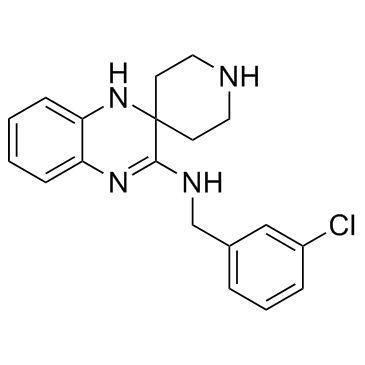| Description |
Liproxstatin-1 is a potent ferroptosis inhibitor, with IC50 of approximately 38 nM.
|
| Related Catalog |
|
| Target |
EC50: 38 nM (ferroptosis)[2]
|
| In Vitro |
Liproxstatin-1 prevents BODIPY 581/591 C11 oxidation in Gpx4−/− cells. Moreover, Liproxstatin-1 does not interfere with other classical types of cell death, such as TNFα-induced apoptosis and H2O2-induced necrosis, and in the bona fide L929 model of TNFα/zvad-induced necroptosis[1]. Liproxstatin-1 has great antiferroptotic activity with EC50 of appr 38 nM. Fer-1 and Liproxstatin-1 are inherently good, but not great, radical-trapping antioxidants, but they are excellent in phospholipid bilayers. Fer-1 (10 μM) and Liproxstatin-1 (10 μM) do not exhibit significant inhibitory activity in the 15-LOX-1 overexpressing cells, and the concentration is almost 1000-fold higher than their EC50s for subverting RSL3-induced ferroptosis in these cells (15 and 27 nM, respectively)[2].
|
| In Vivo |
Liproxstatin-1 (10 mg/kg, i.p.) suppresses ferroptosis in human cells, Gpx4−/− kidney and in an ischaemia/reperfusion-induced tissue injury model[1].
|
| Cell Assay |
To induce the knockout of Gpx4, cells are seeded onto 96-well plates (1,000 cells per well) and treated with 1 μM 4-OH-tamoxifen (TAM) after plating. Cell viability is assessed at different time points after treatment (usually 72 h) using AquaBluer, unless stated otherwise, as an indicator of viable cells. Alternatively, cell death is also quantified by measuring released lactate dehydrogenase (LDH) activity using the Cytotoxicity Detection Kit.
|
| Animal Admin |
Animals includes in the treatment study of inducible Gpx4−/− mice are equally distributed between sex and weight, with typically 8-10 weeks of age. The average weight within the groups is between 22 and 24 g. Groups are formed to have comparable numbers of females/males of the same age. Animal weight is arranged to have a similar distribution between females and males. For the pharmacological inhibitor experiments, CreERT2;Gpx4fl/fl mice are injected on day 1 and 3 with 0.5 mg TAM dissolved in Miglyol. On day 4, compound treatment is started (Liproxstatin-1: 10 mg/kg) along with vehicle control (1% dimethylsulphoxide (DMSO) in PBS). Liproxstatin-1 and vehicle control are administered once daily by i.p. injection. Survival analysis is performed using the GraphPad Prism software and statistical analysis is done according to the log-rank test.
|
| References |
[1]. Friedmann Angeli JP, et al. Inactivation of the ferroptosis regulator Gpx4 triggers acute renal failure in mice. Nat Cell Biol. 2014 Dec;16(12):1180-91. [2]. Zilka O, et al. On the Mechanism of Cytoprotection by Ferrostatin-1 and Liproxstatin-1 and the Role of Lipid Peroxidation in Ferroptotic Cell Death. ACS Cent Sci. 2017 Mar 22;3(3):232-243
|
